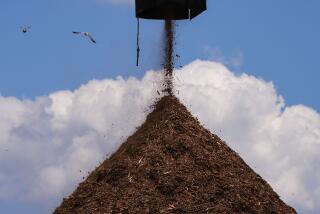Logging Town Looks for New Ways to Survive : Economics: Residents of Butte Falls, Ore., are struggling to deal with the impacts of construction slump and the spotted owl controversy.
BUTTE FALLS, Ore. — When Butte Falls first started looking at life after logging, folks didn’t like what they saw.
“The perception was that this was a logging town, and if the logging was gone, Butte Falls would cease to exist,” said Harvey Boyle, school superintendent in the southern Oregon town of 485.
Now the town has a new point of view.
Ever since timber harvesting fell off because of the construction slump and the northern spotted owl, people have been talking about making money in other ways: bottling and selling the water from Big Butte Creek or packaging the wild mushrooms that grow in the woods nearby.
“We never looked beyond the trees (before). It’s really picking up in terms of things we never looked at,” said Steve Stratton, a former school administrator who is among those advancing new ideas.
Many in town also give credit to Joyce Hailicka, chairwoman of the local economic development committee. She helped the town establish its own library and museum inside a railroad depot-style building hauled into town.
“Suddenly, there was the realization that, ‘Yeah, we can do something ourselves,’ ” said Chuck Anderson, the Butte Falls district ranger for the Rogue River National Forest in southern Oregon.
“They’re really taking charge of the situation, which is unusual from my perspective. They are kind of a leader for small timber-dependent communities.”
Incorporated in 1911, Butte Falls was born around a sawmill powered by the waters of Big Butte Creek. The town, 200 miles south of Portland, was the center of Medford Corp.’s logging operations in the Cascade Range for more than 50 years.
So it is natural that when folks park their pickups around the town square to watch the high school football team on Friday afternoons, they cheer for the Loggers. A statue of a logger carved from a sugar pine log welcomes visitors to the square.
The local tavern is the Log Inn.
But gone are the days when logging could carry a little town. Timber harvesting has been cut by two developments; the recession-plagued building slump, which has lowered demand for lumber and plywood, and the northern spotted owl, a threatened species that has caused the supply of timber from Northwest national forests to plummet.
To preserve habitat for the owl, as well as watersheds, trout streams and other wildlife, the Butte Falls Ranger District on the Rogue River National Forest will be offering only one-eighth of the timber it once did. That means cutting 15 of the 45 full-time Forest Service jobs in the district, said Anderson.
Medford Corp. started accelerating the logging on its land six years ago to make up for the drop in timber harvesting on federal lands, said Vice President Hank Snow. But the company has gone through most of its timber here and no longer needs 30 loggers on the payroll, Snow said. What little logging remains will be done by contractors.
That’s a sharp contrast from earlier days.
“When Medco started in 1936, there were a couple hundred men working here,” said Elga Abbott, 89, who has lived and logged in Butte Falls since 1912.
Yet life isn’t over for this town. School enrollment is up. There is no police officer because the last two people hired couldn’t find a place to live. The few houses and ranches put up for sale were snapped up, some by Californians who came north to retire.
The top two sources of income now are transfer payments for retirees and paychecks for people who commute to jobs in nearby towns, Stratton said.
Although timber can’t carry Butte Falls, the surrounding forests still offer opportunities. One possibility is mushroom farming. Stratton said the industry could take off.
“We know we have four gourmet-quality edible mushrooms that grow here,” he said. “We have pickers. We have brokers who come in from the outside.”
Abbott figures a golf course would be good. Other people are thinking about bottling water from Big Butte Creek, rebuilding a logging railroad for sightseeing tours or enticing drivers to stop in and shop on their way to the resort at Willow Lake, 12 miles away.
Many say Hailicka opened their eyes with the Butte Falls library. After moving here in 1987, she got involved in the Friends of the Library, which was trying to get the Jackson County Library books out of the elementary school and into a home of their own.
They raised almost $65,000 from governments and local residents. Then they found a restaurant in Medford built to look like a railroad depot, and hauled it up the hill--clearing the canyon walls by inches. It now sits on the town square as Butte Falls’ library and museum.
“It’s a visible thing this community can look to,” Boyle said.
Even the loggers wolfing down burgers at the Totem Pole after a morning of elk hunting don’t appear worried about jobs. Ken Bergren figures he will join the morning commuter migration to the valley, if it comes to that.
“Everybody in town knows there are problems in town,” Boyle said. “People know these things, but they are not willing to let the town die.”
Lumber Industry Report Card
Here is a look at some of the top timber companies in the Northwest and how their business has been affected by the recession and the northern spotted owl.
COMPANY: Weyerhaeuser Co.
HEADQUARTERS: Tacoma, Wash.
HOLDINGS: 5.6 million acres of U.S. timberland, including 2.9 million in Oregon and Washington; 53 wood products mills, 20 in Northwest; 12 pulp and paper mills, five in Northwest.
TIMBERLAND AFFECTED BY SPOTTED OWL: 150,000 acres.
EMPLOYEES: 40,621 at end of 1990, down 4,593 from 1989.
1991 REVENUE (first nine months): $6.6 billion.
1991 NET INCOME (first nine months): $172 million.
1990 REVENUE: $9 billion.
1990 NET INCOME: $394 million.
OUTLOOK: Weyerhauser recently underwent a self-appraisal that found its sales and marketing reputation solid, but overall manufacturing processes rating a “C,” William Shields, executive vice president for wood products, told industry analysts in November. The company is refocusing after selling or downsizing nearly 40 businesses and units. It’s emphasizing manufacturing excellence, which includes upgrading mill technology.
As the world’s largest owner of softwood timber, Weyerhaeuser has an advantage as the amount of public timber open to harvest shrinks. The company sees prices exceeding 1988-1989 levels and sees demand increasing while supply is constrained.
The last of Weyerhaeuser’s big-log sawmills, located in Klamath Falls, will close this year.
COMPANY: Georgia-Pacific Corp.
HEADQUARTERS: Atlanta.
HOLDINGS: 8 million acres of timberlands, 613,000 in Oregon and California; 300 wood products and paper mills nationally. Eighty percent share of 2.1 million acres of Maine timberland being sold to Bowater Inc. for $300 million. Thirty-one sawmills and plants in California, Oregon, Washington and Idaho were shut down in first half of 1991 due to timber shortages.
TIMBERLAND AFFECTED BY SPOTTED OWL: not available.
EMPLOYEES: 60,000 nationwide.
1991 REVENUE (first nine months): $8.7 billion.
1991 NET LOSS (first nine months): $1 million.
1990 REVENUE: $12.7 billion.
1990 NET INCOME: $365 million.
OUTLOOK: Chairman T. Marshall Hahn told Financial World Magazine he’s confident in the future of wood products, where the United States remains a strong global competitor. With or without spotted owl set-asides, Hahn foresees continuing shrinkage of Northwest logging capacity, which should improve margins over the next several years, even with only a modest recovery in housing starts.
Georgia-Pacific will be well-positioned in the South to meet an increasing demand for wood products, shipping more Southern pine plywood even to Western points.
COMPANY: Louisiana-Pacific Corp.
HEADQUARTERS: Portland, Ore.
HOLDINGS: 1.5 million acres timberland, including 100,000 acres in Oregon and 500 acres in Northern California; 115 mills, including one in Oregon, 13 in Northern California, two in Washington state.
TIMBERLAND AFFECTED BY SPOTTED
OWL: not available.
EMPLOYEES: 13,000.
1991 REVENUE (first nine months): $1.3 billion.
1991 NET INCOME (first nine months): $47.1 million.
1990 REVENUE: $1.8 billion.
1990 NET INCOME: $91.1 million.
OUTLOOK: Louisiana-Pacific sees itself in a better position than competitors for dealing with old-growth forest protection efforts. Over the past 10 years, the company has made a point of developing products that can be made from small trees and noncontroversial species, such as aspen, lodgepole pine and Southern pine. About 50% of its products are now insulated from supply problems that have plagued plywood and large-dimension lumber.
COMPANY: Boise-Cascade Corp.
HEADQUARTERS: Boise, Ida.
HOLDINGS: 2.8 million acres of timberland, including 1.1 million acres in Oregon and Washington; 22 wood products plants and four pulp and paper mills in Northwest.
TIMBERLAND AFFECTED BY SPOTTED OWL: 5,000 acres in central Washington and western Oregon.
EMPLOYEES: 23,000 nationwide.
1991 REVENUE (first nine months): $3.05 billion.
1991 NET LOSS (first nine months): $63.7 million.
1990 REVENUE: $4.2 billion.
1990 NET INCOME: $75.3 million.
OUTLOOK: Company sees further reductions in timber supply and further industry shrinkage in Northwest, with little opportunity to expand in the South, where public timber supply is at maximum yield.
While housing starts are down, the remodeling and repair market has surpassed new home construction and is increasing at a rate of 2% to 3% annually. Eventually demand will outstrip supply, offering good opportunities for those companies that can stay alive that long.
No plans for shutting down mills.
COMPANY: WTD Industries Inc.
HEADQUARTERS: Portland, Ore.
HOLDINGS: 15 mills operating, 15 closed; 17,000 acres of cut-over timberland.
TIMBERLAND AFFECTED BY SPOTTED OWL: none.
EMPLOYEES: 1,200 as of May 31, 1991, down 1,500 from previous year.
1991 REVENUE (first nine months): $143.9 million.
1991 NET INCOME (first nine months): $2.6 million.
1990 REVENUE: $320.3 million.
1990 NET LOSS: $96.9 million.
OUTLOOK: A young and fast-growing company primarily producing softwood lumber, WTD ran into trouble paying off debt and filed for Chapter 11 bankruptcy protection Jan. 30, 1991. The company blamed the high price of logs on the open market and the downturn in the housing industry.
Under its reorganization plans, WTD would sell off 17 mills, including its only two plywood mills, and concentrate on its 13 best performers, primarily in western Oregon and Washington.
More to Read
Sign up for Essential California
The most important California stories and recommendations in your inbox every morning.
You may occasionally receive promotional content from the Los Angeles Times.










